Early-onset Baldness: Causes, Impact and Solutions
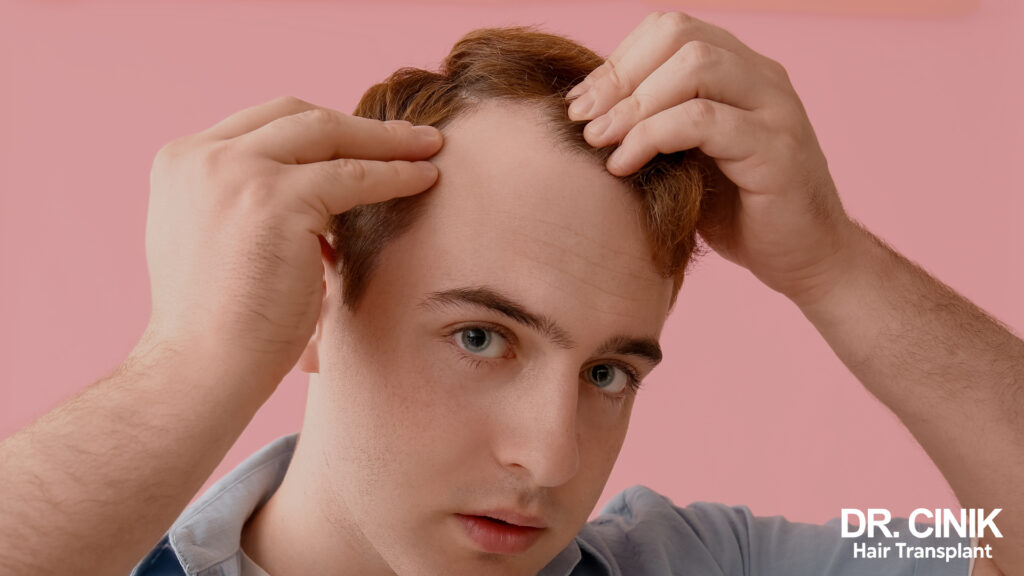
Sommaire
Premature baldness, or premature androgenetic alopecia, is defined as significant hair loss before age 30-35. According to a study by Hamilton (1951), approximately 16% of men aged between 18 and 29 already have moderate to significant baldness. This common form of hair loss can have a considerable psychological impact on the young men.
Recent medical advances now offer effective solutions for slowing the progression of baldness and even restoring a fuller head of hair. In this article, we take a detailed look at the causes, consequences and modern treatments of baldness in young males.

The Causes of Premature Baldness
Genetic Factors
Genetic predisposition plays a major role in the onset of premature baldness. A study conducted by Hagenaars et al. (2017) showed that heredity accounts for around 80% of the predisposition to baldness. The researchers identified more than 70 genetic loci involved in this phenomenon, highlighting the complexity of its inheritance.
The androgen receptor gene, located on the X chromosome, is particularly important in this process. Ellis et al. (2001) have shown that certain variations of this gene increase the sensitivity of hair follicles to male hormones, accelerating their miniaturisation. This discovery partly explains why some men are more likely to develop premature baldness than others, even with similar hormone levels.
Other genes, such as those coding for 5-alpha reductase or aromatase, also play a crucial role in influencing hormone metabolism in the scalp. When combined with other factors, these genetic variations create a breeding ground for premature baldness.
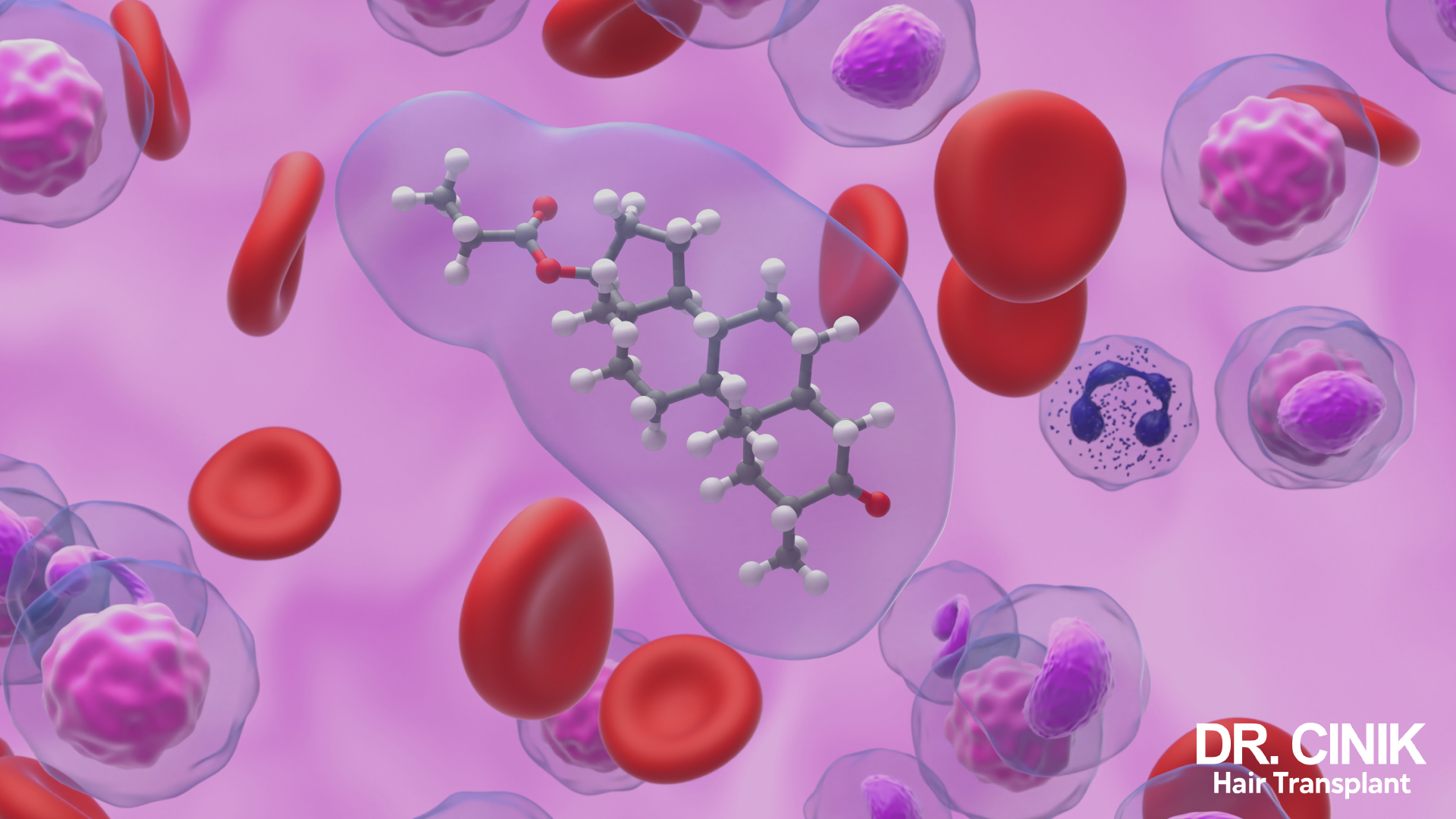
Hormonal Factors
Male hormones, in particular dihydrotestosterone (DHT), are the main players in the miniaturisation of hair follicles. Kaufman (2002) has shown that DHT can reduce the size of sensitive follicles by up to 50%. This miniaturisation process is at the heart of androgenetic baldness.
In genetically predisposed men, increased sensitivity of hormone receptors in the scalp leads to an exaggerated response to normal levels of androgens. This hypersensitivity explains why baldness can occur even in individuals with normal hormone levels.
The role of hormones in baldness is complex and not limited to the action of DHT alone. Recent studies, such as that by Yip et al. (2011), suggest that other hormones, particularly oestradiol, may also play a role in the baldness process, opening up new avenues of research and treatment.

Environmental and Lifestyle Factors
Although secondary to genetic and hormonal factors, certain environmental and lifestyle factors can accelerate the baldness process.
- Chronic stress, for example, has been identified as an aggravating factor. A study by Hadshiew et al. (2004) showed that stress can disrupt the hair growth cycle and accelerate hair loss.
- Air pollution, which is particularly prevalent in urban areas, can also have a negative impact on hair health. Fine particles and other pollutants can damage hair follicles and disrupt their normal growth cycle.
- An unbalanced diet, lacking in nutrients essential for healthy hair, can also contribute to accelerated baldness. Deficiencies in iron, zinc or B vitamins can weaken hair and disrupt its growth.
- Smoking has also been associated with an increased risk of premature baldness. A study by Trüeb (2003) showed that smokers were more likely to develop premature baldness than non-smokers, probably due to the harmful effects of smoking on scalp microcirculation.
- Finally, certain medications, particularly those used to treat cancer or hypertension, can have the side effect of accelerating hair loss.
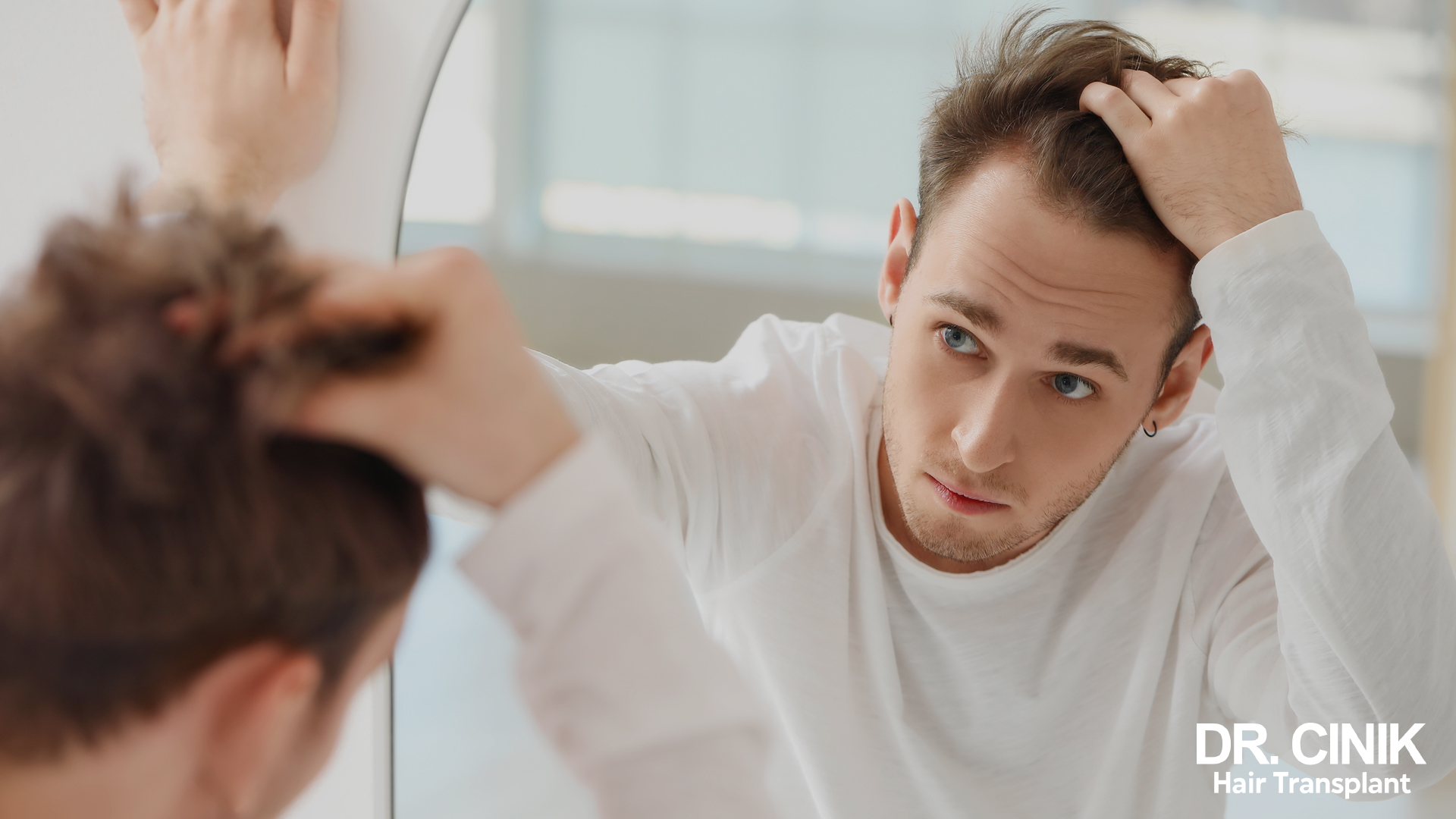
Frequency and Epidemiology
Baldness in young males is more common than is often thought. According to a study by Gan and Sinclair (2005), approximately 25% of men start to lose their hair before the age of 21. This proportion increases with age, reaching 50% of men by the age of 50, as shown by Ellis et al. (2001).
However, there are significant variations according to ethnic origin. Caucasian men are generally the most affected by premature baldness. In contrast, Khumalo et al. (2007) observed a lower prevalence in Asian and African American men. These ethnic differences highlight the importance of genetic factors in the development of baldness.
Several epidemiological studies suggest an increase in the frequency of premature baldness in recent decades. Although the exact reasons for this trend are not yet entirely clear, researchers point the finger at environmental factors and changes in modern lifestyles. Increased stress, pollution and changes in eating habits could all contribute to this increase.
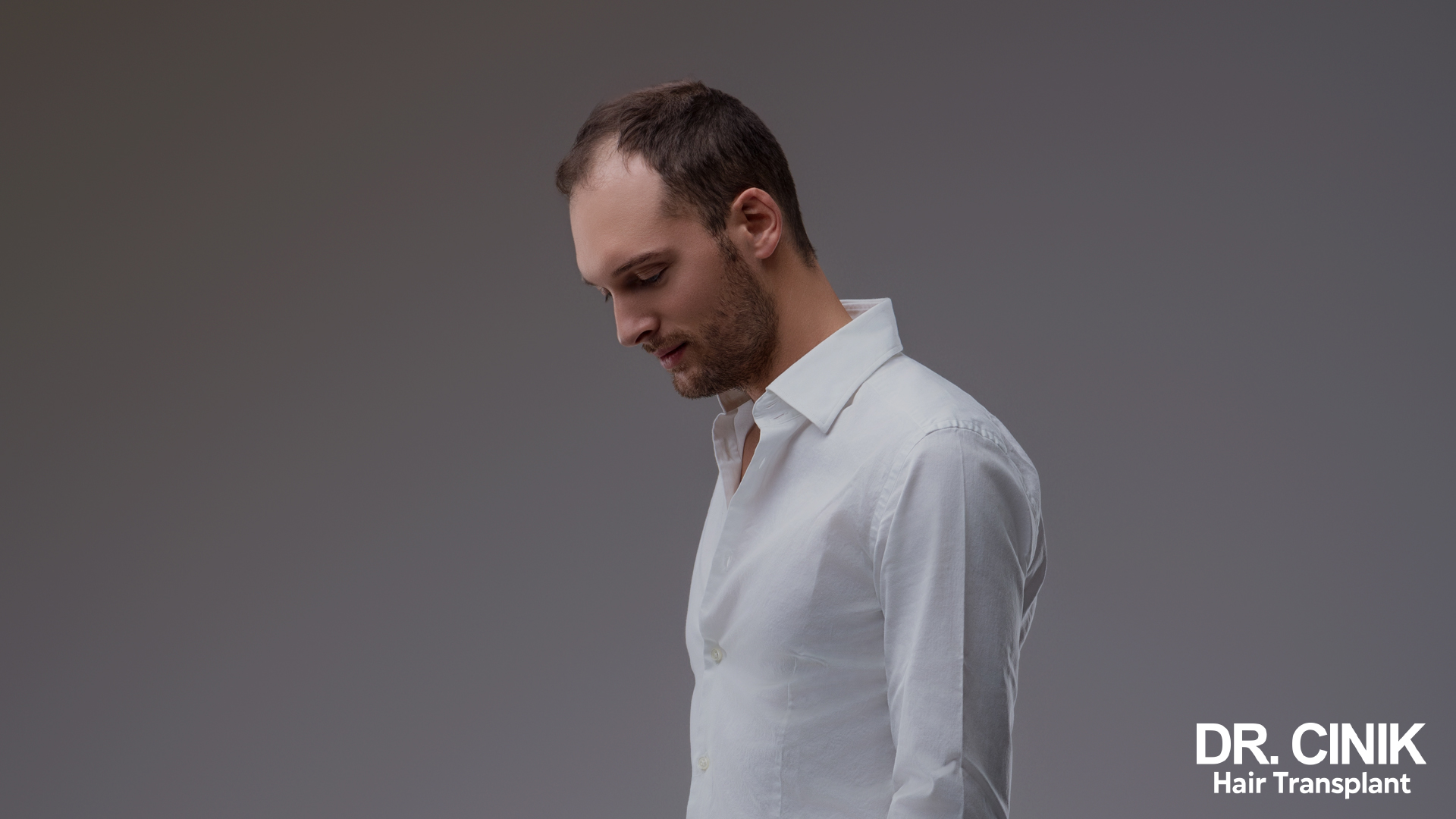
Psychological and Social Impact
Premature baldness can have significant psychological and social consequences, particularly in young men. A study by Cash (1992) found that 75% of balding men felt less confident because of their hair condition. This impact on self-esteem can have repercussions in many areas of life.
The loss of self-confidence associated with premature baldness can manifest itself in various ways. Some men may develop a negative body image, feeling less attractive or older than their actual age. This negative self-perception can lead to social anxiety, making everyday interactions more stressful and less satisfying.
In some cases, premature baldness can even lead to depressive states. A recent study by Tabolli et al. (2013) highlighted a higher prevalence of depressive symptoms in men suffering from androgenetic alopecia, particularly in younger men.
Premature baldness can also have an impact at work. Although discrimination based on appearance is illegal in the UK, studies have shown that bald men may be perceived as less dynamic or less competent in certain professional contexts, particularly in occupations where appearance plays an important role.
In personal relationships, premature baldness can affect self-confidence when dating. Some men may hesitate to enter into relationships for fear of being rejected because of their appearance.
It’s also important to bear in mind that the perception of baldness can vary considerably depending on culture and time. In some societies, baldness is seen as a sign of maturity and wisdom, while in others it may be associated with a loss of vitality and attractiveness. These social perceptions can influence the psychological impact of premature baldness on the individuals concerned.
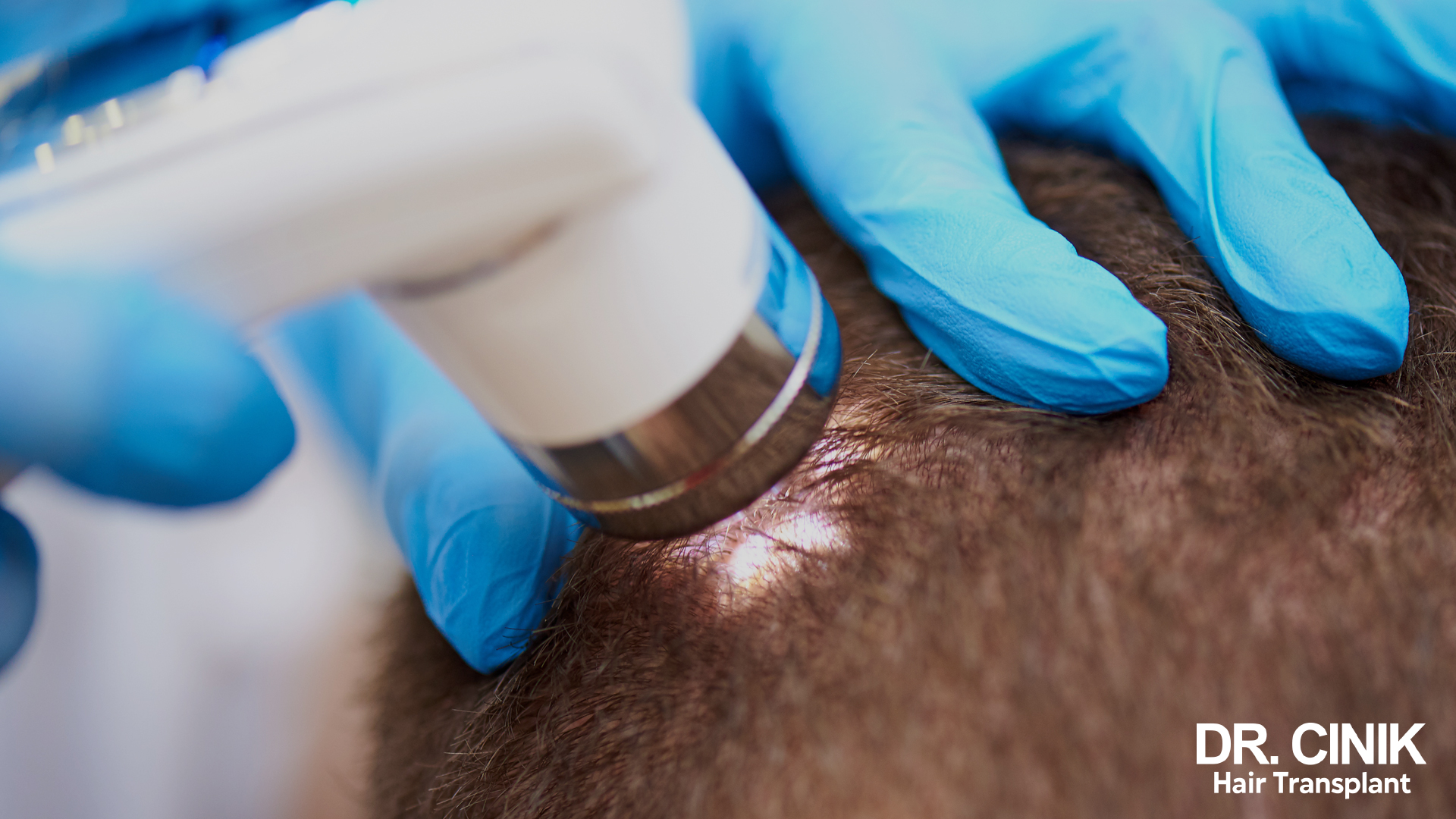
Diagnosis and Assessment
The diagnosis of premature baldness is based on a combination of clinical elements and sometimes additional tests. Clinical examination of the scalp is the first essential step. The doctor assesses the distribution of hair loss and hair density in different areas of the scalp, and looks for signs of follicle miniaturisation.
Family history, given the strong genetic component of androgenetic baldness, the presence of similar cases in the family, particularly in first-degree relatives, can guide the diagnosis.
Standardised assessment scales, such as the Hamilton-Norwood scale, can be used to classify the degree of baldness. This scale, widely used in research and clinical practice, helps to monitor changes in the condition over time and to assess the effectiveness of treatments.
In some cases, further tests may be necessary to rule out other causes of hair loss or to refine the diagnosis:
- Blood tests may be prescribed to check hormone levels (testosterone, DHT) and look for any nutritional deficiencies (iron, zinc, vitamins) that could be contributing to hair loss.
- The trichogram, a technique that involves analysing a sample of hair taken from the scalp, can provide valuable information about the hair growth cycle and the percentage of follicles in the telogen phase (resting phase).
- In some cases, a biopsy of the scalp may be performed to rule out other dermatological conditions that could mimic androgenetic baldness.
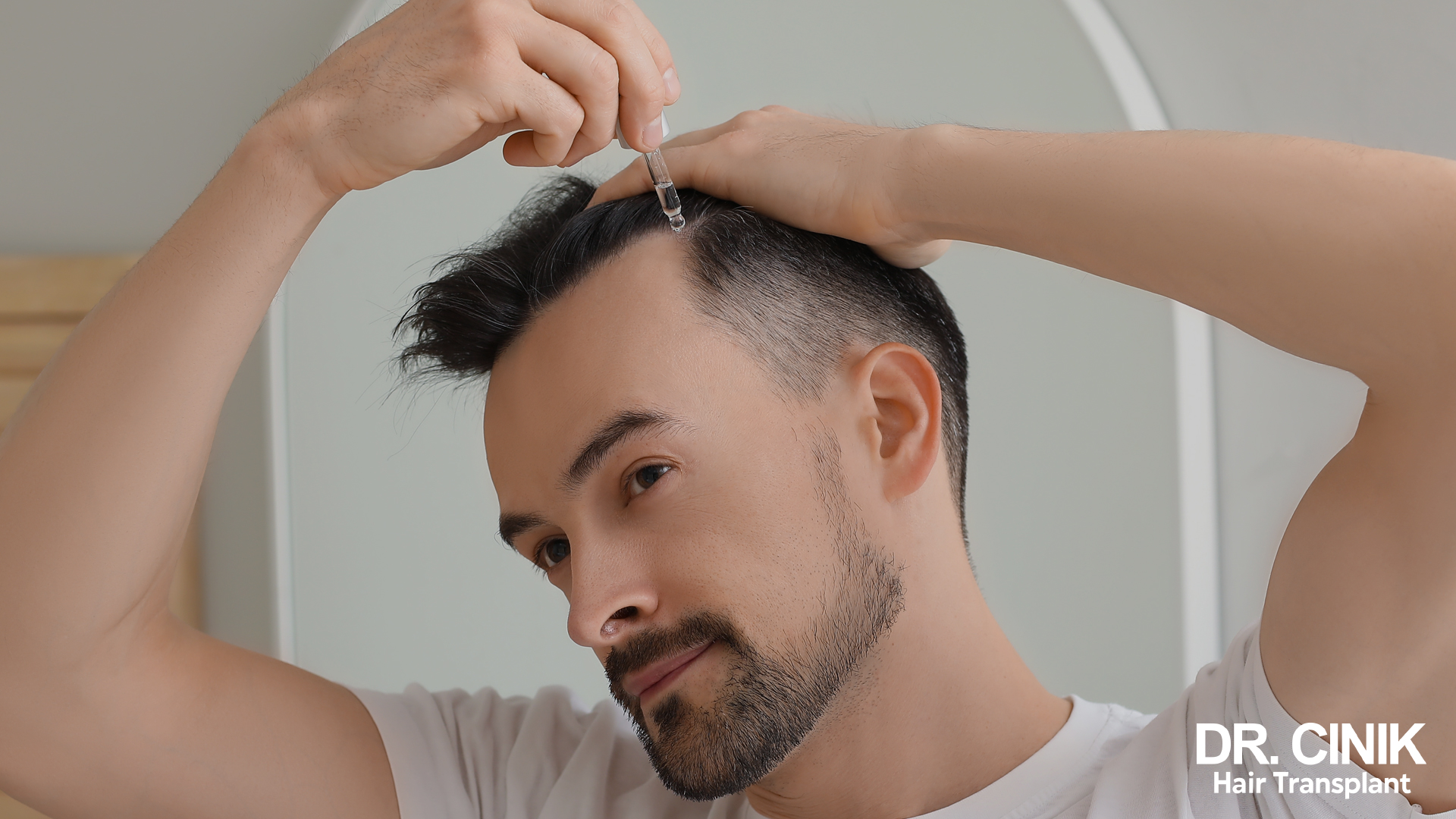
Medical Treatments
There are several medical treatment options available for early baldness. These treatments aim to slow the progression of hair loss and, in some cases, stimulate regrowth.
Minoxidil
Minoxidil is one of the oldest and best-studied treatments for androgenetic baldness. Initially developed as an antihypertensive drug, its effects on hair growth were discovered by chance. Olsen et al. (2007) showed that 5% topical minoxidil increased hair density by 18% after 48 weeks of treatment.
Minoxidil acts as a vasodilator, improving blood circulation to the scalp. It also prolongs the anagen (growth) phase of the hair cycle and increases the diameter of miniaturised hair. Its exact mechanism of action is not fully understood, but recent studies suggest that it may stimulate the production of growth factors in hair follicles.
Minoxidil is applied topically once or twice a day. It is available as a solution or foam, in concentrations of 2% or 5%. Side-effects are generally minor and localised, including scalp irritation and facial fuzz growth in some users.
It is important to note that the results of treatment with minoxidil may take several months to become visible, and that stopping treatment generally leads to a resumption of hair loss.
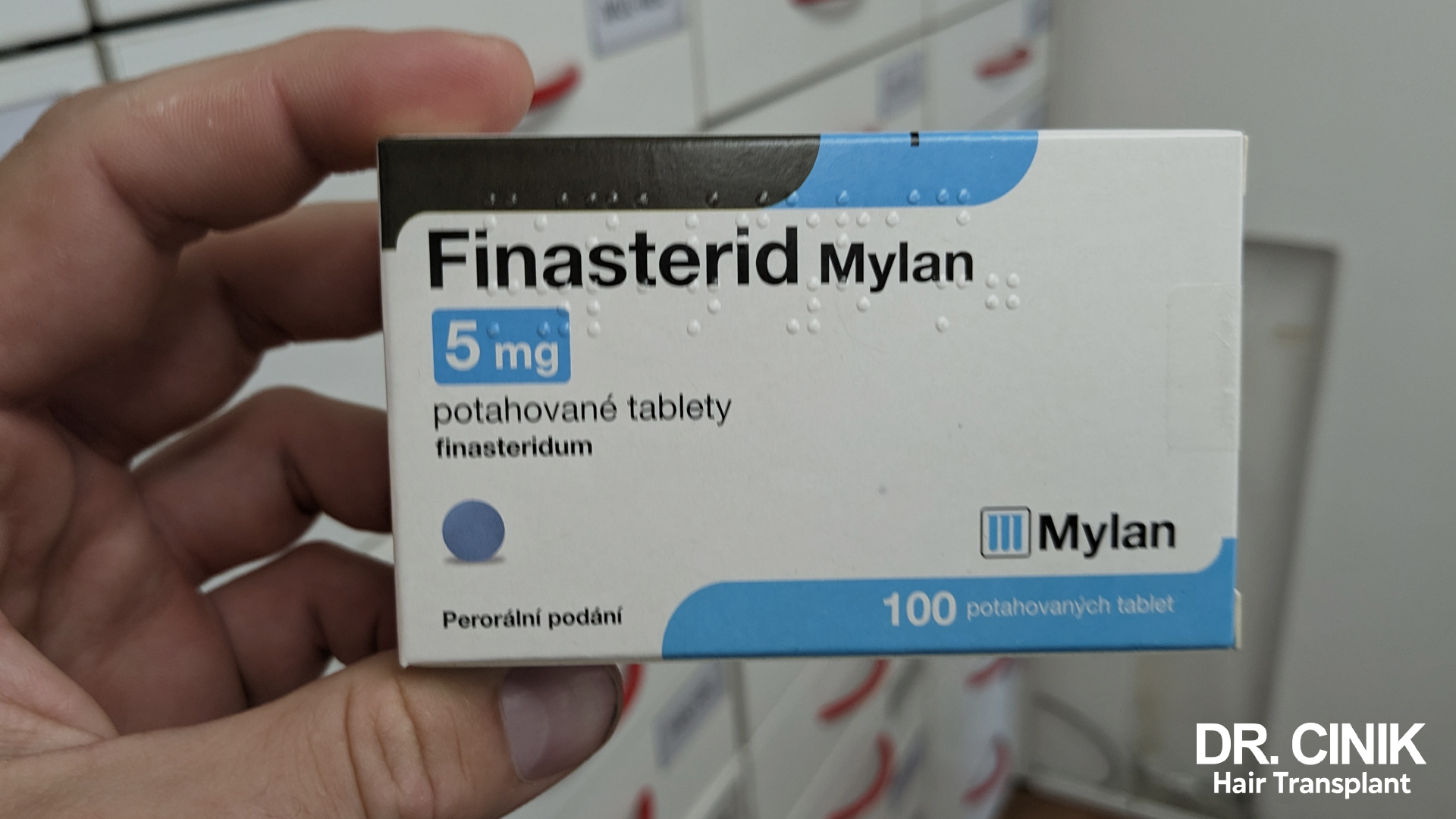
Finasteride
Finasteride is an inhibitor of 5-alpha reductase, the enzyme responsible for converting testosterone into DHT. Kaufman et al. (1998) showed that 66% of men treated with finasteride saw an improvement in their hair after 2 years of treatment.
Finasteride works by reducing DHT levels in the scalp, thereby slowing the process of hair follicle miniaturisation. It is particularly effective in preserving existing hair and can stimulate moderate regrowth, especially in areas of recent baldness.
The drug is taken orally, generally at a dose of 1 mg per day. However, it’s important to note that finasteride can have unwanted side effects. The most common include:
- Loss of libido
- Erectile dysfunction
- Ejaculation disorders
- Depression
These side effects, although relatively rare (2-3% of patients), can be persistent in some individuals, even after treatment has been stopped. This is known as post-finasteride syndrome, the reality and frequency of which are the subject of debate in the medical community.
A long-term study conducted by Rossi et al. (2011) showed that the efficacy of finasteride was maintained over a period of 10 years in the majority of users, underlining its value in the long-term treatment of premature baldness.

Other Medical Treatments
Other therapeutic options are also available or under development:
- Dutasteride, a more potent 5-alpha reductase inhibitor, has shown superior efficacy to finasteride in some studies, such as that by Harcha et al. (2014). However, it is not yet approved for the treatment of baldness in many countries, including the UK.
- Topical anti-androgen treatments, such as fluridil, are under development and could offer an alternative for patients who do not wish to use systemic treatments.
- Specific dietary supplements, enriched with vitamins and minerals essential for hair health, can be used to complement the main treatments, although their effectiveness is less well documented.
These medical treatments must be prescribed and monitored by a specialist doctor such as Dr Cinik or any other trichologist. A preliminary assessment and regular monitoring are necessary to optimise the effectiveness of the treatment and minimise the risk of side effects.

Surgical Solutions
When medical treatments are not enough and hair loss is already advanced, hair transplants can offer a lasting and effective solution for restoring hair density. Modern hair transplant techniques have evolved considerably in recent years, offering increasingly natural and aesthetic results.
Modern Hair Transplantation Techniques
Dr Cinik specialises in two cutting-edge hair transplant techniques:
- The Sapphire FUE technique: This method uses a sapphire blade to make more precise incisions when extracting follicular units. This allows for faster healing and more natural results.
- The DHI (Direct Hair Implantation) technique: This advanced method allows grafts to be implanted directly into the scalp without the need to create implantation channels beforehand. It offers precise control over the direction, angle and depth of each implant, ensuring an even more natural result.
These modern techniques give very natural results, with a graft survival rate of over 90%.
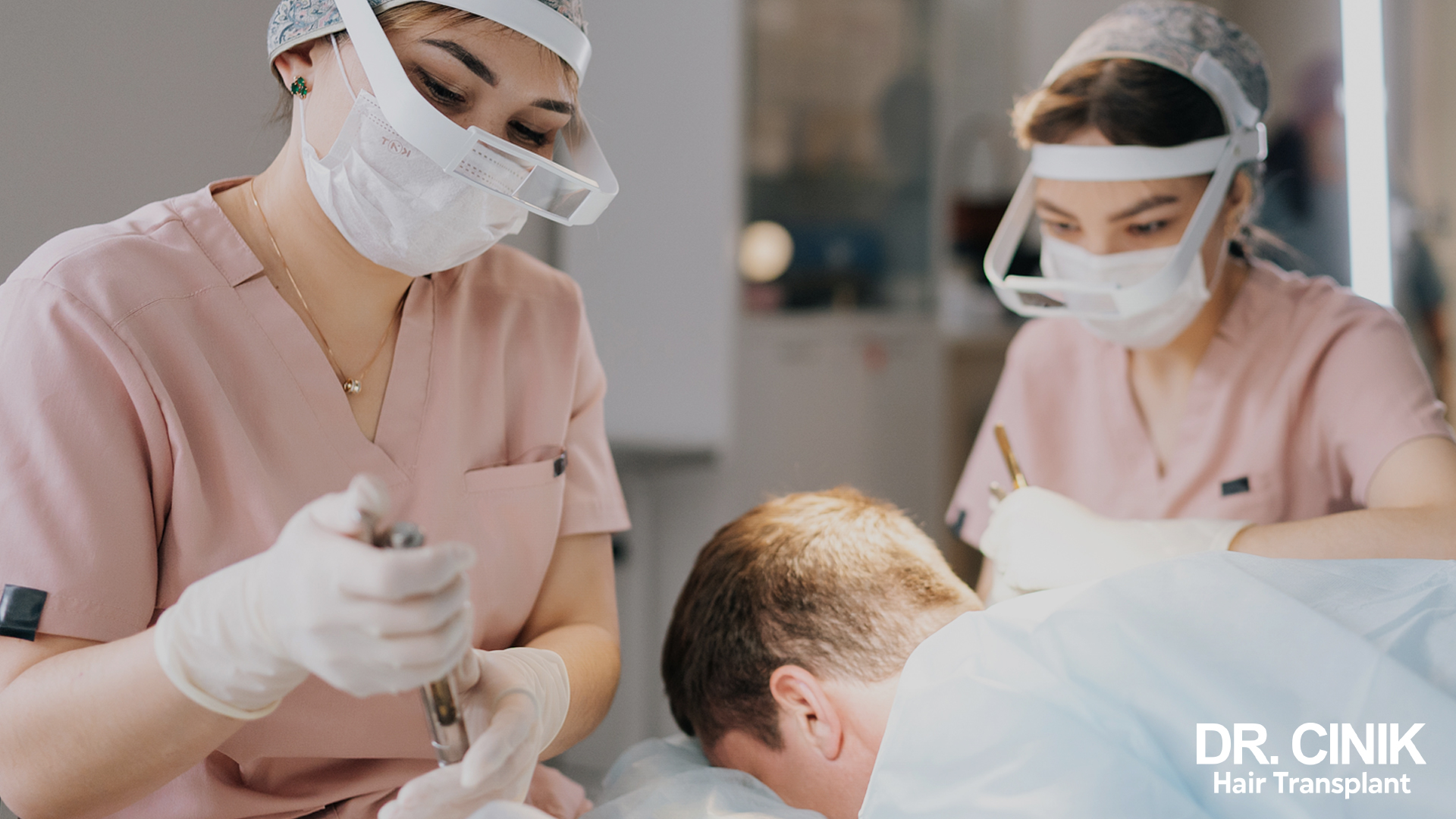
Planning and Carrying Out the Transplant
Hair transplants carried out too early are generally not recommended, particularly for young men under the age of 25. As Dr Cinik explains in his article “Hair transplant at 20: is it too early?”, there are several reasons for this caution:
- The progression of baldness is often not stabilised before the age of 25-30.
- Early intervention can lead to unnatural results in the long term if baldness continues to progress.
- There is a risk of premature depletion of the donor area, limiting future hair restoration options.
The success of a hair transplant depends on careful planning. The surgeon must take several factors into account:
- The extent of current and future hair loss
- The quality and quantity of the donor area
- The patient’s expectations
- The patient’s age and the stabilisation of their baldness
During the pre-operative consultation, Dr Cinik carries out a detailed analysis of the scalp, discusses the patient’s objectives and draws up a personalised treatment plan. This stage is crucial to ensuring an optimal and long-lasting result.
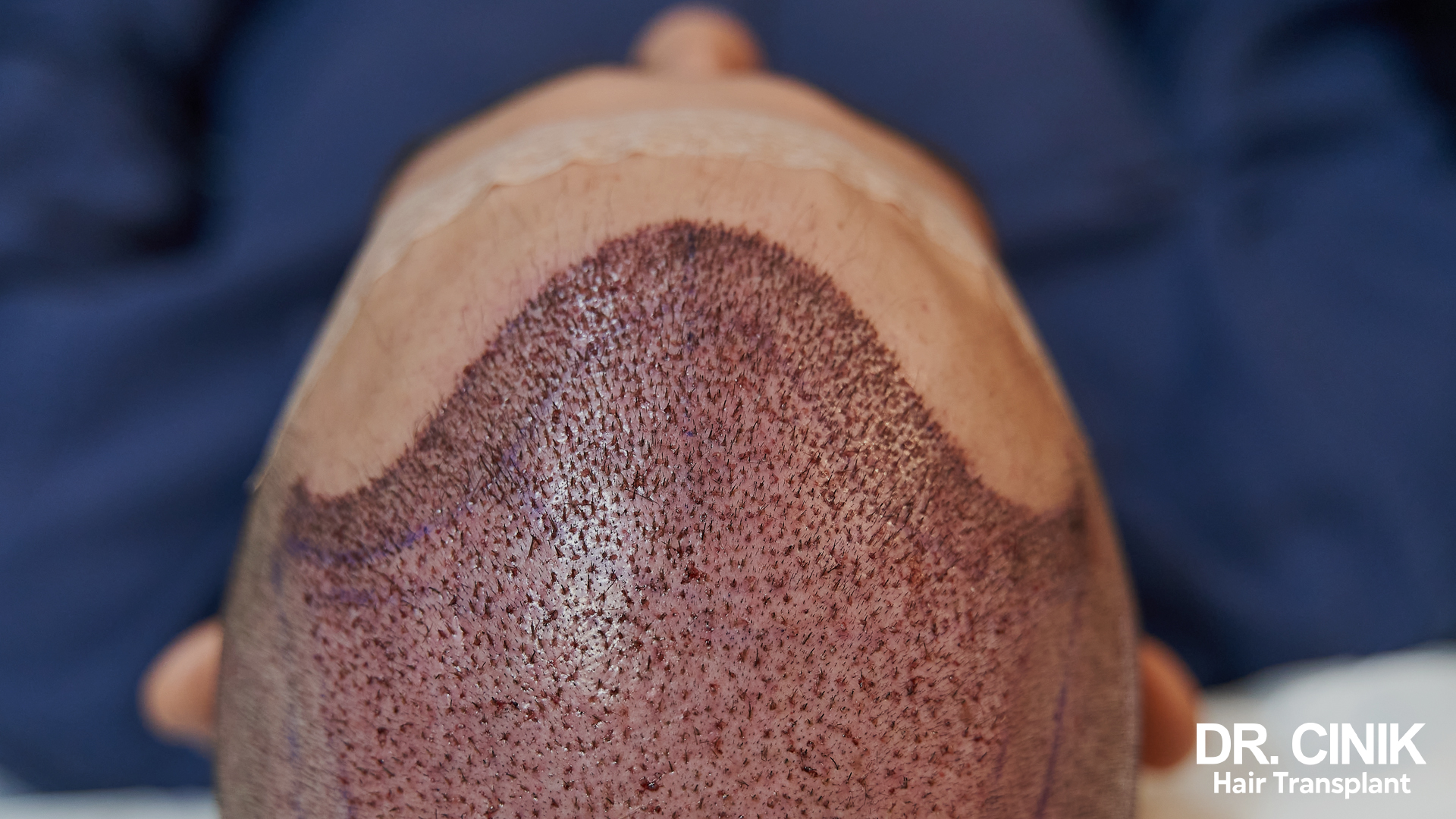
Results and Follow-up
The results of a modern hair transplant are generally very satisfactory. A study conducted by Bernstein et al. (2005) showed that over 90% of patients were satisfied with their results one year after the operation.
It is important to note that transplanted hair retains the genetic characteristics of its area of origin. As a result, they generally resist the progression of baldness, offering a long-lasting result. However, baldness can continue to progress in untreated areas, which is why it is important to combine surgery with medical treatments to preserve existing hair.
Post-operative follow-up is essential to optimise results. Dr Cinik offers a personalised follow-up programme, including advice on scalp care and the use of complementary treatments if necessary.

Prevention and Slowing Down
Although the genetic predisposition to premature baldness cannot be changed, there are several strategies to prevent or slow its progression. These approaches aim to maintain an optimal environment for hair health and minimise aggravating factors.
Diet and Supplements
A balanced diet plays a crucial role in hair health. Rushton (2002) has highlighted the importance of certain nutrients for hair growth:
- Proteins: essential for the formation of keratin, the main component of hair.
- Iron: iron deficiency can lead to hair loss, particularly in women.
- Zinc: involved in protein synthesis and cell division.
- Group B vitamins, particularly biotin: important for the metabolism of fatty acids and amino acids.
- Antioxidants (vitamins C and E): protect hair follicles against oxidative stress.
In certain cases, targeted supplementation can be beneficial, but it must be carried out under medical supervision to avoid any risk of overdosing.

Stress Management
Chronic stress can accelerate hair loss. Stress management techniques such as meditation, yoga or regular exercise can help to maintain a hormonal balance favourable to hair health. A study by Peters et al (2006) showed that stress reduction could improve hair growth in some individuals.
Adapted Hair Care
Using the right hair care products is essential for maintaining a healthy scalp:
- Avoid aggressive treatments such as frequent colouring or straightening.
- Use gentle, sulphate-free shampoos that cleanse gently without irritating the scalp.
- Apply nourishing conditioners and masks to keep hair hydrated.
Dr Cinik often recommends specific products for his patients, adapted to their hair type and condition.

Early Consultation
One of the most important aspects of prevention is early consultation with a specialist at the first signs of abnormal hair loss. Early intervention can often significantly slow the progression of baldness and produce better long-term results.
Dr Cinik stresses the importance of regular monitoring, even in the absence of visible symptoms, for men with a family history of premature baldness. Regular check-ups can detect the first signs of follicle miniaturisation and enable preventive action to be taken.
Preventive Treatments
In some cases, the early use of treatments such as minoxidil or finasteride may be recommended as a preventive measure. A study by Rossi et al. (2011) showed that early use of finasteride could significantly delay the onset of baldness in men at risk.
However, the decision to initiate preventive treatment must be taken on a case-by-case basis, carefully weighing up the potential benefits against the risks of side effects.

Conclusion
Baldness in young males is a complex phenomenon, resulting from the interaction between genetic, hormonal and environmental factors. Although it can have a significant impact on quality of life, medical and surgical advances now offer effective solutions for treating it.
The modern approach to treating premature baldness is based on a combination of strategies:
- Early and accurate diagnosis, enabling rapid intervention.
- Medical treatments such as minoxidil and finasteride, which can slow the progression of baldness and stimulate regrowth.
- Advanced surgical techniques such as FUE Sapphire and DHI, offering natural, long-lasting results.
- A preventive approach, including a balanced diet, good stress management and appropriate hair care.
Ongoing research in the field of trichology offers promising prospects for the future. Targeted gene therapies, stem cell treatments and new drugs are currently being studied and could revolutionise the treatment of baldness in the years to come.
Sources :
Bernstein, R. M., Rassman, W. R., Seager, D., Shapiro, R., Cooley, J. E., Norwood, O. T., … & Reed, M. L. (2005). The future of hair restoration surgery. Dermatologic Surgery, 31(7), 826-831. https://pubmed.ncbi.nlm.nih.gov/16029675/
Cash, T. F. (1992). The psychological effects of androgenetic alopecia in men. Journal of the American Academy of Dermatology, 26(6), 926-931. https://pubmed.ncbi.nlm.nih.gov/1607410/
Ellis, J. A., Stebbing, M., & Harrap, S. B. (2001). Genetic analysis of male pattern baldness and the 5α‐reductase genes. Journal of Investigative Dermatology, 116(5), 916-919. https://pubmed.ncbi.nlm.nih.gov/11231320/
Ellis, J. A., Stebbing, M., & Harrap, S. B. (2001). Polymorphism of the androgen receptor gene is associated with male pattern baldness. Journal of Investigative Dermatology, 116(3), 452-455. https://pubmed.ncbi.nlm.nih.gov/11511330/
Gan, D. C., & Sinclair, R. D. (2005). Prevalence of male and female pattern hair loss in Maryborough. Journal of Investigative Dermatology Symposium Proceedings, 10(3), 184-189. https://pubmed.ncbi.nlm.nih.gov/16382660/
Hadshiew, I. M., Foitzik, K., Arck, P. C., & Paus, R. (2004). Burden of hair loss: stress and the underestimated psychosocial impact of telogen effluvium and androgenetic alopecia. Journal of Investigative Dermatology, 123(3), 455-457. https://pubmed.ncbi.nlm.nih.gov/15304082/
Hagenaars, S. P., Hill, W. D., Harris, S. E., Ritchie, S. J., Davies, G., Liewald, D. C., … & Deary, I. J. (2017). Genetic prediction of male pattern baldness. PLoS genetics, 13(2), e1006594. https://pubmed.ncbi.nlm.nih.gov/29146897/
Hamilton, J. B. (1951). Patterned loss of hair in man; types and incidence. Annals of the New York Academy of Sciences, 53(3), 708-728. https://pubmed.ncbi.nlm.nih.gov/14819896/
Harcha, W. G., Martínez, J. B., Tsai, T. F., Katsuoka, K., Kawashima, M., Tsuboi, R., … & Chetty, D. (2014). A randomized, active-and placebo-controlled study of the efficacy and safety of different doses of dutasteride versus placebo and finasteride in the treatment of male subjects with androgenetic alopecia. Journal of the American Academy of Dermatology, 70(3), 489-498. https://pubmed.ncbi.nlm.nih.gov/24411083/
Kaufman, K. D. (2002). Androgens and alopecia. Molecular and cellular endocrinology, 198(1-2), 89-95. https://pubmed.ncbi.nlm.nih.gov/12573814/
Kaufman, K. D., Olsen, E. A., Whiting, D., Savin, R., DeVillez, R., Bergfeld, W., … & Gormley, G. J. (1998). Finasteride in the treatment of men with androgenetic alopecia. Journal of the American Academy of Dermatology, 39(4), 578-589. https://pubmed.ncbi.nlm.nih.gov/9777765/
Khumalo, N. P., Jessop, S., Gumedze, F., & Ehrlich, R. (2007). Hairdressing and the prevalence of scalp disease in African adults. British Journal of Dermatology, 157(5), 981-988. https://pubmed.ncbi.nlm.nih.gov/17854370/
Olsen, E. A., Whiting, D., Bergfeld, W., Miller, J., Hordinsky, M., Wanser, R., … & Kohut, B. (2007). A multicenter, randomized, placebo-controlled, double-blind clinical trial of a novel formulation of 5% minoxidil topical foam versus placebo in the treatment of androgenetic alopecia in men. Journal of the American Academy of Dermatology, 57(5), 767-774. https://pubmed.ncbi.nlm.nih.gov/17761356/
Peters, E. M., Arck, P. C., & Paus, R. (2006). Hair growth inhibition by psychoemotional stress: a mouse model for neural mechanisms in hair growth control. Experimental dermatology, 15(1), 1-13. https://pubmed.ncbi.nlm.nih.gov/16364782/
Rossi, A., Cantisani, C., Scarnò, M., Trucchia, A., Fortuna, M. C., & Calvieri, S. (2011). Finasteride, 1 mg daily administration on male androgenetic alopecia in different age groups: 10‐year follow‐up. Dermatologic therapy, 24(4), 455-461. https://pubmed.ncbi.nlm.nih.gov/21910805/
Rushton, D. H. (2002). Nutritional factors and hair loss. Clinical and experimental dermatology, 27(5), 396-404. https://pubmed.ncbi.nlm.nih.gov/12190640/
Tabolli, S., Sampogna, F., di Pietro, C., Mannooranparampil, T. J., Ribuffo, M., & Abeni, D. (2013). Health status, coping strategies, and alexithymia in subjects with androgenetic alopecia: a questionnaire study. American journal of clinical dermatology, 14(2), 139-145. https://pubmed.ncbi.nlm.nih.gov/23413102/
Trüeb, R. M. (2003). Association between smoking and hair loss: another opportunity for health education against smoking?. Dermatology, 206(3), 189-191. https://pubmed.ncbi.nlm.nih.gov/12673073/
Yip, L., Zaloumis, S., Irwin, D., Severi, G., Hopper, J., Giles, G., … & Sinclair, R. (2011). Gene‐wide association study between the aromatase gene (CYP19A1) and female pattern hair loss. British Journal of Dermatology, 165(2), 406-413. https://pubmed.ncbi.nlm.nih.gov/21564068/



